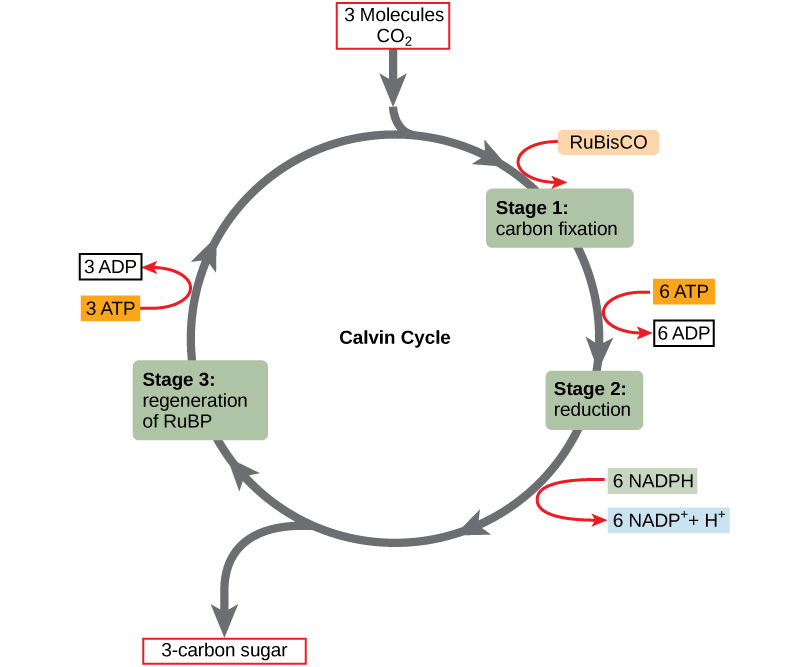5.4 The Calvin Cycle
After the energy from the sun is converted and packaged into ATP and NADPH, the cell has the fuel needed to build food in the form of carbohydrate molecules. The carbohydrate molecules made will have a backbone of carbon atoms. Where does the carbon come from? The carbon atoms used to build carbohydrate molecules come from carbon dioxide, the gas animals exhale with each breath. The Calvin cycle is the term used for the reactions of photosynthesis that use the energy stored by the light-dependent reactions to form glucose and other carbohydrate molecules.
Location of the Calvin Cycle
In plants, carbon dioxide (CO2) enters the chloroplast through the stomata and diffuses into the stroma of the chloroplast—the site of the Calvin cycle reactions where sugar is synthesized (5.4.1). The reaction is named after the scientist who discovered it and references the fact that the reactions function as a cycle.

Figure 5.4.1 Description
This diagram effectively conveys the key steps of photosynthesis and the relationship between light-dependent and light-independent reactions.
Main Components and Processes:
- Light Reactions (Right Side of the Image): Sunlight provides energy for photosynthesis. Water (H₂O) is split into oxygen (O₂), which is released. The light reactions take place in the thylakoid membranes of the chloroplast. ATP (adenosine triphosphate) and NADPH (nicotinamide adenine dinucleotide phosphate) are produced.
- Calvin Cycle (Left Side of the Image): Occurs in the stroma of the chloroplast. CO₂ (carbon dioxide) is incorporated into the cycle. The molecule RuBP (ribulose bisphosphate) is involved in carbon fixation. 3-PGA (3-phosphoglycerate) is an intermediate molecule. G3P (glyceraldehyde-3-phosphate) is formed, which can be used to produce sugars. ATP and NADPH from the light reactions provide energy and reducing power.
- Chloroplast Structure (Inset Diagram): Shows the outer and inner membranes. The stroma is the fluid-filled space where the Calvin cycle occurs. Grana are stacks of thylakoids where the light reactions take place.
Overall Process:
- Light reactions convert light energy into chemical energy (ATP and NADPH).
- The Calvin cycle uses ATP and NADPH to fix carbon dioxide and produce glucose.
Stages of the Calvin Cycle
The Calvin cycle reactions (Figure 5.4.2) can be organized into three basic stages: fixation, reduction, and regeneration. In the stroma, in addition to CO2, two other chemicals are present to initiate the Calvin cycle: an enzyme abbreviated RuBisCO and the molecule ribulose bisphosphate (RuBP). RuBP has five atoms of carbon and a phosphate group on each end.
RuBisCO catalyzes a reaction between CO2 and RuBP, which forms a six-carbon compound that is immediately converted into two three-carbon compounds (3-Phosphoglycerate, 3-PGA). This process is called carbon fixation because CO2 is “fixed” from its inorganic form into organic molecules.
ATP and NADPH use their stored energy to convert the three-carbon compound, 3-PGA, into another three-carbon compound called glyceraldehyde-3-phosphate (G3P). This type of reaction is called a reduction reaction because it involves the gain of electrons. A reduction is the gain of an electron by an atom or molecule. The molecules of ADP and NAD+, resulting from the reduction reaction, return to the light-dependent reactions to re-energize.
One of the G3P molecules leaves the Calvin cycle to contribute to the formation of glucose (C6H12O6). Because glucose has six carbon atoms, it takes six turns of the Calvin cycle to make one molecule of glucose (one for each carbon dioxide molecule fixed). The remaining G3Ps are used in the regeneration of RuBP, which allows the cycle to start again. ATP from the light-dependent reactions provides the necessary energy for this regeneration process.

Exercises 5.4.1
Text Description
- Stroma
- Granum
- Thylakoid space
- Thylakoid membrane
- The production of carbohydrate molecules from G3P
- The formation of RuBP from G3P molecules
- The use of RUBISCO to form 3-PGA
- The conversion of CO<sub>2</sub> to an organic compound
- RuBP
- ADP
- 3-PGA
- G3P
- The middle part of the Calvin cycle could take place.
- None of the parts of the Calvin cycle could take place.
- All parts of the Calvin cycle could take place.
- The last part of the Calvin cycle could not take place.
- sugar
- products
- water
- respiration
- photosynthesis
- oxygen
- photosynthesis
- water
- carbon dioxide
- oxygen
- sugar
- carbon dioxide
“5.3 The Calvin Cycle” from Biology and the Citizen by Colleen Jones is licensed under a Creative Commons Attribution 4.0 International License, except where otherwise noted.

